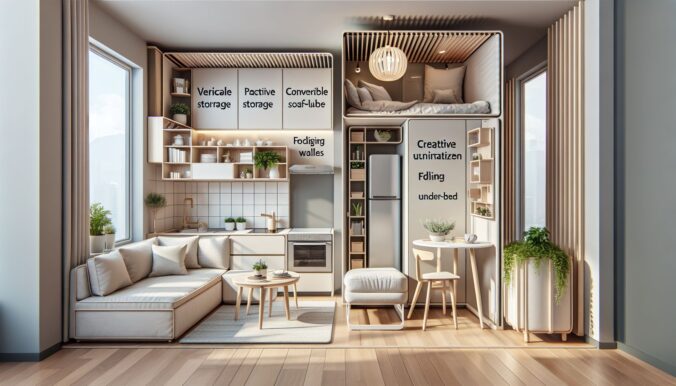Do you feel like your living space is shrinking day by day? Are you struggling to find enough room for all your belongings in your tiny apartment? Don’t worry, you’re not alone! Many people face the challenge of making the most out of limited space. But with the right interior design tips and strategies, you can transform even the smallest of spaces into a functional and stylish oasis. In this blog post, we’ll share some practical and budget-friendly ways to maximize space and make your home feel more spacious. Let’s dive in!
Declutter and Organize
The first step to maximizing space in a small area is to declutter and organize. Start by going through your belongings and getting rid of items that you no longer use or need. Be ruthless in your decluttering process – if you haven’t used something in the past year, chances are you don’t need it. Once you’ve decluttered, it’s time to organize what’s left. Invest in storage solutions such as bins, baskets, and shelves to keep your belongings neat and tidy. Utilize vertical space by installing floating shelves or wall-mounted organizers to free up floor space.
Choose Multi-Functional Furniture
When you’re working with limited space, every piece of furniture needs to count. Opt for multi-functional furniture that serves more than one purpose. For example, a sofa bed can provide seating during the day and a sleeping area for guests at night. A coffee table with storage compartments can help keep clutter at bay. Look for furniture pieces that can be easily folded or collapsed when not in use to maximize space in your home.
Use Light Colors
When it comes to making a small space feel larger, light colors are your best friend. Opt for a neutral color palette of whites, creams, and light grays to create the illusion of space. Light-colored walls, furniture, and décor can reflect natural light and make a room feel airy and open. If you’re feeling adventurous, you can add pops of color with accent pieces such as cushions, rugs, or artwork. Just be mindful not to overwhelm the space with too many bold colors, as this can make it feel smaller.
Embrace Vertical Space
In a small space, every inch counts – including vertical space. Make use of tall bookshelves, floor-to-ceiling curtains, and hanging plants to draw the eye upward and create the illusion of height. Install shelves above doorways or windows to store books or display decorative items. Hanging plants or artwork at different levels can also add visual interest and make the room feel more dynamic. By utilizing vertical space, you can free up floor space and make your small room feel more spacious.
Let in Natural Light
Natural light can do wonders for a small space, making it feel brighter and more open. Keep window treatments to a minimum to allow as much natural light in as possible. Opt for sheer curtains or blinds that can be easily opened during the day. If your space lacks natural light, you can use mirrors to reflect light and create the illusion of a larger space. Place a large mirror opposite a window to bounce light around the room and make it feel brighter.
Invest in Smart Storage Solutions
When you have limited space, it’s important to think outside the box when it comes to storage. Look for furniture pieces that can double as storage, such as ottomans with hidden compartments or beds with built-in drawers. Use under-bed storage boxes to store out-of-season clothing or extra linens. Consider installing a pegboard on a wall to hang kitchen utensils or office supplies. By thinking creatively about storage, you can keep your small space clutter-free and functional.
Create Zones
In a small space, it’s important to define different areas for different activities. Create zones within a room by using area rugs, furniture arrangement, or room dividers. For example, you can designate a corner for reading by placing a cozy armchair and a lamp, or create a home office area with a desk and shelving unit. By visually separating different areas, you can make the room feel more organized and purposeful. Just be sure to keep pathways clear to maintain an open and spacious feel.
Scale Down
When choosing furniture and décor for a small space, it’s important to scale down. Oversized furniture can overwhelm a room and make it feel cramped. Instead, opt for furniture that is proportional to the size of the room. Choose a sleek sofa with slim arms, a dainty coffee table, or a compact dining set. When it comes to décor, less is more. Select a few statement pieces that reflect your style without overcrowding the space. By scaling down your furniture and décor, you can create a harmonious and balanced environment in your small space.
Make Use of Nooks and Crannies
Every small space has hidden nooks and crannies that can be utilized for storage or display. Look for opportunities to maximize these spaces, such as under stairs, alcoves, or awkward corners. Install custom shelving or built-in cabinets to make the most out of these areas. You can create a cozy reading nook under a staircase, a mini home office in an alcove, or a display shelf in a corner. By thinking creatively about these unique spaces, you can add character and functionality to your small home.
Conclusion
Maximizing space in a small area doesn’t have to be a daunting task. By following these practical interior design tips and strategies, you can make the most out of your limited space and create a functional and stylish home. Remember to declutter and organize, choose multi-functional furniture, use light colors, embrace vertical space, let in natural light, invest in smart storage solutions, create zones, scale down, and make use of nooks and crannies. With a little creativity and planning, you can transform your small space into a cozy and inviting retreat. Happy decorating!
